Overcoming racism in Michigan
Kimberly Hayes Taylor |
Friday, November 24, 2017
Michiganders are unifying their communities, and finding peaceful pathways to overcome racism, and the divisiveness, segregation and disparities it causes.
In Michigan, like the rest of America, racism is a great divider.
Its culprits sometimes are unconscious, and its complexities create inequities in education, healthcare, housing and food consumption. However, as difficult as it is to dissect and dissolve, Michiganders are unifying their communities, and finding peaceful pathways to overcome racism, and the divisiveness, segregation and disparities it causes.
While the nation remains embroiled in protests, racial strife and political division, Michigan Nightlight has found a plethora of creative, innovative healing efforts across the state, where people are setting aside differences to work together to address inequities. Governments, nonprofits, hospitals, schools and foundations are supporting programs and initiatives making big differences in communities.
In metro Detroit, for example, teachers in multiethnic communities such as Hamtramck, Dearborn and southwest Detroit are developing more inclusive curriculums, teaching empathy and understanding of other cultures, and engaging students in political and community-based action.
At the Kosciuszko Middle School in Hamtramck, many of Nancy Walter’s students are immigrants from Yemen and Bangladesh. She is challenged to help find materials and curriculum to engage students who are “crossing a huge cultural, religious, and language gulf.”
To help, Walters organizes cultural celebration days, including International Mother Language Day, a holiday widely celebrated in Bangladesh. Students decorate the school in their national flags, make posters in their first languages, serve home-cooked food and dress in their native attire.
You can check out that story and video here.
 Nancy Walter, ESL teacher at Kosciuszko Middle School
Nancy Walter, ESL teacher at Kosciuszko Middle School
In the New Center district of Detroit, another teacher is making a difference in bridging gaps for students of color.
Michael Payne is a ninth grade math teacher at Henry Ford Academy: School for Creative Studies, a public charter school for 6th through 12th graders interested in art and design. He finds ways to make the subject more enjoyable and relevant.
As a young teaching professional, Payne connects math to relatable subjects, such as sports and current events, for his predominately African-American students from Detroit while acting as a father/big brother figure because he has found “the American cultural of education doesn’t teach to black children, doesn’t teach for black children.”
Read the full story here.
 Michael Payne is a ninth grade math teacher at Henry Ford Academy: School for Creative Studies
Michael Payne is a ninth grade math teacher at Henry Ford Academy: School for Creative Studies
Across the state, W. K. Kellogg Foundation awarded Battle Creek Public Schools district an unprecedented $51 million grant to help it address racial division after a New York University Metropolitan Center for Research and Equity report found the region was “racially, culturally and linguistically diverse but deeply segregated.”
The five-year grant will help to revamp the district’s curriculum starting with pre-kindergarten; change outcomes for low-income, black and Latino students achieving at lower levels than their peers; and retrain and retain teachers. The funding builds on previous efforts in the region as part of the BC Vision to create a community-led economic develop plan to address jobs, talent development and cultural vitality in Battle Creek.
Read the full story here.
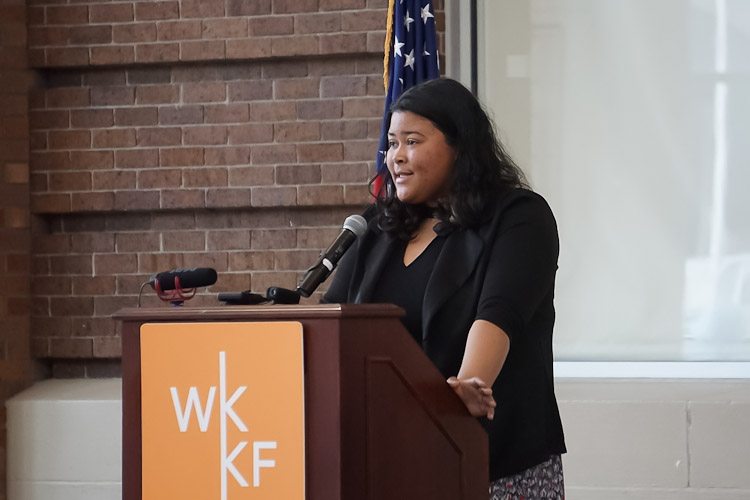 A Battle Creek High School senior tells of her success thanks to the BCPS
A Battle Creek High School senior tells of her success thanks to the BCPS
Along with the educational disparities being addressed, health disparities are also being tackled successfully, despite some tough odds.
Black children are often disadvantaged even before they are born. In Detroit, even with its four major health systems, thousands of doctors and countless social service programs, the infant mortality rate rivals that of many developing nations. It means in any given year, 150 to 200 babies born in the city die before their first birthday. Most of them are black.
To address this imbalance, Women-Inspired Neighborhood Network focuses on reaching new parents in underserved pockets of Detroit. The program matches pregnant women with community health workers who provide support and health monitoring throughout the pregnancy and for one year following birth. With a regional long-term goal of decreasing the infant mortality rate, the program is making headway. The initial cohort of more than 300 parents resulted in no infant deaths.
Read more about this story here.
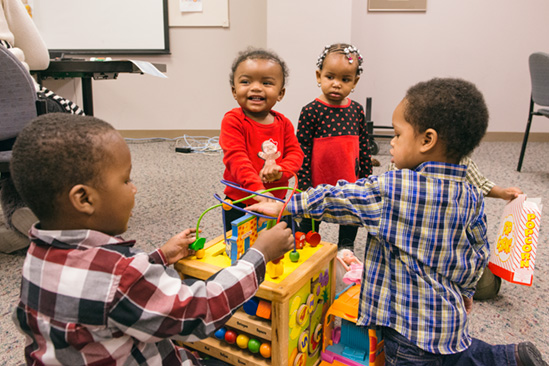 Babies at a WIN meeting
Babies at a WIN meeting
Other organizations are working to keep black children and families healthy by encouraging them to make dietary changes and to get more exercise.
Research shows African Americans disproportionately suffer from food-related health conditions such obesity, hypertension and Type II diabetes because of social factors such as eating food loaded with salt, fat or sugar; lack of access to fresh and organic produce; and a shortage of healthier eating options.
So Detroit Food Policy Council (DFPC) and the nonprofit Metropolitan Organization Strategy Enabling Strength (MOSES) teamed up to offer “A Taste of African Heritage” to address inequities in Detroit’s food systems and to help Detroiters deal with health and wellness through eating. Christ the King Catholic Church kitchen was transformed into an African kitchen for a six-week cooking class focusing beans and rice, spices, greens, tubers and mashes, and fruits and vegetables.
Read the full story here.
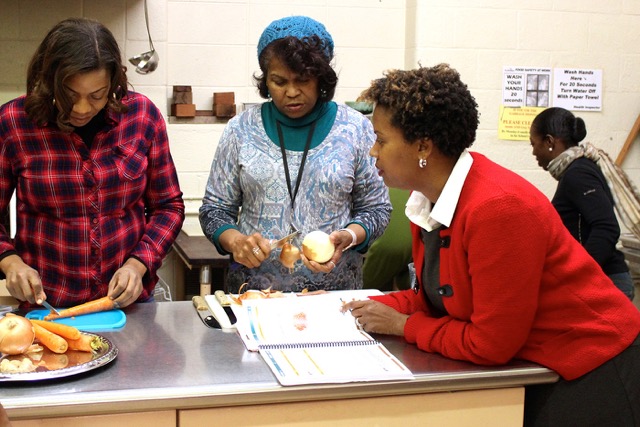 Instructor and nutritionist Winona Bynum (right) calls the shots from the ATOAH recipe book
Instructor and nutritionist Winona Bynum (right) calls the shots from the ATOAH recipe book
For some time, a healthy lifestyle has been difficult for Pontiac residents, who are predominately black. The vehicle-centric city has wide, difficult-to-cross roads and often-overgrown sidewalks. Although the city is in Oakland County, one of the wealthiest counties in the state, Pontiac has different socioeconomics with health disparities including chronic disease, lack of access to healthy food choices, and a higher poverty rate.
To address the issue, a host of community partners, social service agencies, educational organizations, churches, hospitals, and nonprofits are working to make Pontiac a healthier place to live. Initiatives include pop-up farmers markets that sell produce about 30 percent lower than most grocery stores and a cluster of primary care and dental clinics working together to address the health needs of uninsured residents who can’t afford to pay.
The city also is pushing active living. The Healthy Pontiac, We Can (HPWC) initiative engages 600 children in sports, cheer, dance and tumbling through the Police Athletic League and encourages the use of the city’s 29 parks. Other groups have teamed on a Complete Streets strategy; the 10-year comprehensive non-motorized plan intends to make the city’s streets safer for walking, bicycling and running.
Read more about this story here.
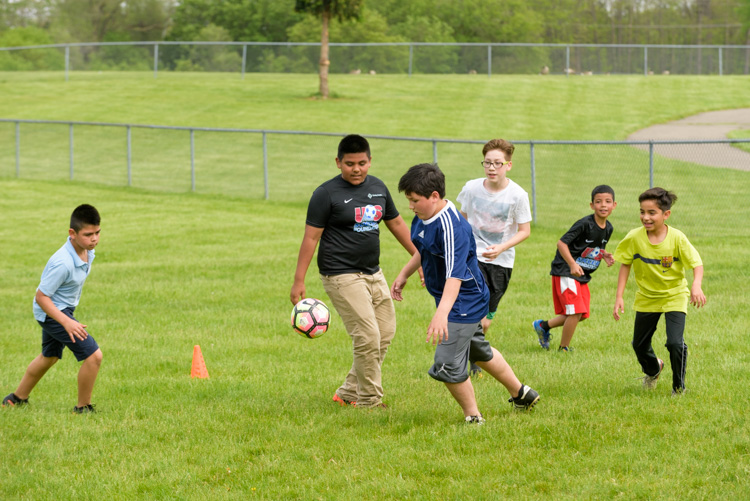 Soccer for Success at Owen Elementary. Photo by Doug Coombe.
Soccer for Success at Owen Elementary. Photo by Doug Coombe.
Other efforts in metro Detroit are working to bridge an outdoor adventure gap to help more minority youth walk, hike, and connect with nature.
Data from the National Park Service (NPS) and the Outdoor Foundation shows that minorities are underrepresented in outdoor pursuits and often lack access to the natural world. Detroit Inspiring Connections Outdoors (ICO) offers wilderness experiences and environmental education mainly with the Fauver-Martin Boys & Girls Club in Highland Park. The group has gone camping and canoeing. Earlier this year, the young people took their first ski trip with the Jim Dandy Ski Club, the country’s first black ski club.
Outdoors Empowerment Network provides free “gear libraries” and training for adults who can check out gear to use with groups of children. The organization is working with Detroit ICO, the National Park Service in Detroit, the YMCA of Metropolitan Detroit, and others to revive a campground in Detroit’s Rouge Park, once a popular Boy Scouts site. These groups are collaborating to make it a destination for local children to go camping – many of them for the first time.
Read the full story here.
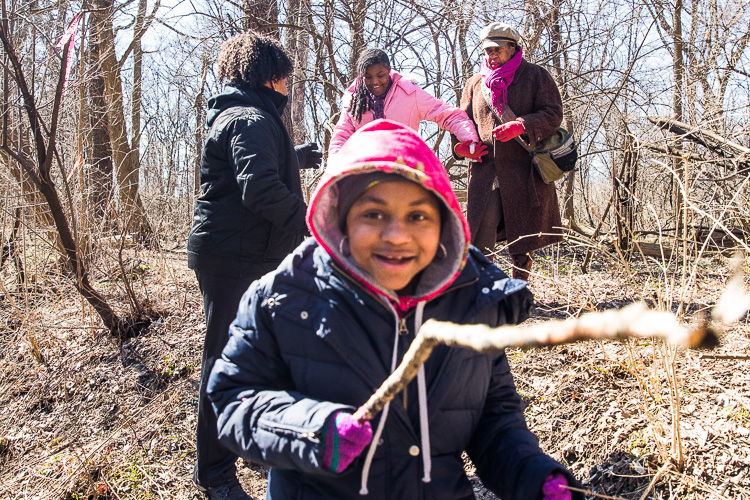 Attending a hike with Detroit Inspiring Connections Outdoors at Rouge Park. Photos by David Lewinski
Attending a hike with Detroit Inspiring Connections Outdoors at Rouge Park. Photos by David Lewinski
Michigan Nightlight has published many other stories from across the state of people moving forward together as diverse, cohesive communities. They illustrate the state’s potential to conquer the challenges of racism that have historically persisted; to unify rather than alienate; and to work toward racial healing and harmony. We look forward to continuing this coverage in 2018.